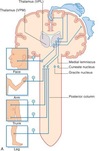Somatic Sensation and Ascending Pathways Flashcards
(17 cards)
Which modalities of sensation are carried by the dorsal-column medial lemniscus pathway?
Light Touch
Joint Position Sense
Vibration
Two Point Discrimination
“functions of evolved species, allow complex tasks”

Which modalities of sensation are carried by the spinothalamic pathway?
Pain
Temperature
Crude Touch
“essential senses required for primitive species to survive”

What is the difference between rapidly adapting receptors and slowly adapting receptors and where may they be found?
Rapidly Adapting Receptors
action potentials produced by receptor stimulation eventually reduce in frequency and evetually reduce awareness e.g. mechanoreceptors in buttocks
Slowly Adapting Receptors
actions potentials produced by receptors do not reduce in frequency as the perception is always required - often for protection e.g. nociceptors

What is the bodies receptive field and how does this change the ability of the CNS to localise detail?
receptive field is the area of the body from which the nervous system receives input from multiple sensory receptors that converge on a single sensory neurone e.g. multuple pressure receptors in the skin on the arm, but all locatise to the dermatome innervated by the spinal nerve at C6
the greater the receptive field, the lower the acuity; smaller the receptive field, the higher the acuity

How does the appreciation of the somatic innervation of the hand differ between the primary sensory neurones and the homunculus?
primary sensory neurones contribute to the dermatomal segmentation of the somatic sensory innervation of the hand
the homunculus is unable to apprecaite the dermatomal distribution of the hand and the cortex processes the entire hand as a single unit

Would a patient with an isolated lesion of the dorsal-column medial lemniscus pathway, present with signs on the ipsilateral or contra-lateral side below the lesion?
Isolated lesions of DC pathway in the cord, lead to IPSILATERAL signs below the lesion

Would a patient with an isolated lesion of the spinothalamic pathway present with signs on the ipsilateral or contra-lateral side below the lesion?
Isolated lesions of spinothalamic tract in the cord, lead to CONTRALATERAL signs below the lesion

How does the anatomical location of decussation of the second order sensory neurones differ between the spinothalamic and dorsal-column pathway?
Dorsal Column Pathway
decussate in the medulla
Spinothalalmic Pathway
decussate in the dorsal horn at the spinal level of the sensory afferent nerve
Outline the sensory pathway in the dorsal-column-medial lemniscus system
first order (synapse medulla) > second order (synapse thalamus) > thrid order (synapse cortex)
- first order sensory neurone enters spinal cord at respentive spinal level
- ascends on the IPSILATERAL side to medulla
- synapses with secondary order neurone in medulla and decussate to CONTRALATERAL side
- ascends on contralateral side to thalamus via the Cuneate and Gracile Nuclei (collectively the medial lemniscus)
- synapses with third order neurone in thalamus
- ascends to the appropriate area of cortex (homunculus)

Outline the sensory pathway in the spinothalamic system
first order (synapse dorsal horn) > second order (synapse thalamus) > third order (synapse cortex)
- first order sensory neurone enters spinal cord at respective spinal level
- synapses with secondary order neurone in the dorsal horn and decussates to CONTRALATERAL side via the central white commisure
- ascends on contralateral side to thalamus
- synapse with third order neurone in thalamus
- ascends to the appropriate area of cortex (homunculus)

What is the relation between the Cuneate / Gracile Nuclei and the areas of the body with which they concerned with its sensory innervation?
both located in the medulla oblongata
Cuneate Nucleus
carries information from vertebral level T6 and above
Gracile Nucleus
carries information from vertebral levels T7 and below

The dorsal-column medial lemniscus pathway and spinothalamic pathway differ in their anatomical arrangement of the tracts carrying axons from the upper and lower bodily regions.
Which pathway has the tracts carrying sensory innervation from the lower half of the body located most medially in the cord?
Dorsal-column Medial Lemniscus Pathway
- In the DC pathway the lower body maps to the medial portion of the tract*
- In the spinothalamic tract the lower body maps to the lateral/superficial parts of the tract*





Outline why rubbing the skin around a painful area helps to alleviate pain
- pain detected by nociceptors carried by C fibres to spinal cord
- mechanoreceptors in the skin detect the rubbing and carry these impulses along A fibres to the spinal cord
- A fibres stimulate inhibitory interneurons that prevent pain signals being perceived







